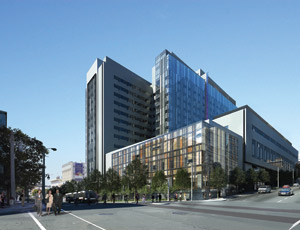After New Jersey Gov. Chris Christie (R) halted the $8.7-billion ARC tunnel to Manhattan in October, transportation firms were left with gaping holes in their plans. The Christie administration returned with a new five-year capital program for the New Jersey Dept. of Transportation that starts with a $3.5-billion fiscal 2012 spending plan effective next month. Although the plan puts a greater emphasis on new highway and bridge construction, firms expect stiff competition for upcoming bids, and critics warn that a future funding stream remains uncertain.

In relative terms, the future prospects for transportation could have been worse. Christie approved deep cuts at several state agencies in response to budget woes during the recession, yet transportation investment remains essentially flat.
Between the NJDOT, New Jersey Transit, New Jersey Turnpike Authority and Port Authority of New York and New Jersey, several agencies are procuring work, says Greg Kelly, president of the Americas transportation division at Parsons Brinckerhoff. PB, which was on the ARC tunnel team, hopes that megaprojects on the horizon could move forward. High on its wish list is the Port Authority’s plans for a Goethals Bridge replacement and the raising of the Bayonne Bridge.
“To see projects like that move forward would be very good for the industry,” Kelly says.
In the meantime, competition is fierce for design work, says Glen Schetelich, partner and New Jersey regional director for Hardesty & Hanover, New York. “The Turnpike Authority and the DOT have work, but I can tell you a lot of firms are going after it,” he says.
The five-year plan, unveiled in January, spreads capital dollars statewide, thanks in part to funds redirected from the ARC project. The FY 2012 budget divvies $2.3 billion to DOT and $1.2 billion to NJ Transit. It includes $1.1 billion for roads and bridges.
In addition to federal and state dollars, the plan taps directly into the state’s toll- and fee-funded agencies. The Port Authority will chip in $1.8 billion toward four projects, including a $1-billion rehabilitation of the three-mile-long multibridge Pulaski Skyway that links Newark and Jersey City, and a new $480-million Wittpenn Bridge between Kearny and Jersey City.
The plan has its critics. Earlier this year, state Senate President Stephen Sweeney (D) assailed the lack of a long-term funding mechanism for the state’s Transportation Trust Fund. “Billions of dollars in more borrowing is just pushing the real costs onto future taxpayers,” Sweeney said in a statement. “Redirecting ARC tunnel money is just another in a long string of one-shot gimmicks. Throwing the Pulaski Skyway onto the shoulders of the Port Authority is just asking someone else to take on your problems. There is nothing in the plan that will provide long-term fiscal stability to the TTF.”

Still, there’s not much the Democrat-controlled Legislature can do about it, says Derek Roseman, spokesman for the Senate Majority Office. The governor has the authority to sell capital bonds, and most of the plan doesn’t require legislative approval.
“We don’t have sticking points on projects,” Roseman says, “but it struck us as hypocritical that the governor won’t go fully to ’pay as you go’ through a dedicated funding source, such as [an increase in the] gas tax or another source.”
The governor’s five-year blueprint trims debt funding levels from the previous plan, and it increases “pay as you go” funding to 37% from 10.6% without raising the gas tax, counters Joe Dee, DOT spokesman.
Dept. of Transportation Commissioner James Simpson says none of the state’s recent capital plans have set a permanent TTF funding mechanism. “It has been the accepted practice of administrations of both parties to identify funding for transportation plans in five-year increments, and this solid, funded, five-year plan meets that benchmark,” he says.
Despite the partisan divide, there is general consensus that infrastructure requires proper investment, says Thomas DiGangi Jr., executive director of Associated General Contractors of New Jersey. “The conversation is really about how to pay for it, not about whether it matters,” he says. “The public agencies ... we see them trying to do as much as they can from a capital standpoint, with less. They have flat budgets—or have reduced staffing and are not filling staff—but are still trying to put out substantial programs.”
Project Pipeline
The ARC tunnel elimination cast a shadow across the landscape, leaving the $2.3-billion widening of the New Jersey Turnpike as the state’s highest-profile project. Still, other projects are getting attention, as design work progresses and contractor bids loom. One of DOT’s biggest projects could break ground next summer—the $1-billion Direct Connect. The project aims to streamline the set of ramps linking Interstate 295, Interstate 76 and Rt. 42 in the corridor between Philadelphia and Atlantic City.
The Pulaski Skyway is set for construction contracts next year, starting what is envisioned as a 10-year program, says PB’s Kelly, whose firm is on the design team.
Timetables are murkier for the Goethals and Bayonne bridges. The Port Authority has design money budgeted for the six-lane replacement for the Goethals and the effort to raise the Bayonne structure’s deck to 215 ft from 151 ft, which would allow larger ships to reach Port Newark and Port Elizabeth. The authority cited budget constraints for delaying the $1.6-billion Goethals project, and now is reviewing eight proposals for an alternative financing plan to have a private entity design, build, finance and maintain a new structure. Meanwhile, the agency’s board has committed $1 billion for the Bayonne project, which is still in design.
Funding constraints also have postponed the authority’s planned modernization of Terminal A at Newark Liberty International Airport.
Various smaller-scale projects are moving ahead, such as DOT’s plan to widen the Garden State Parkway. The agency is completing a $225-million phase, adding two lanes to 17 miles in the central part of the state, and bids go out this summer for a new $358-million effort to add two lanes to a 15-mile stretch between Tom’s River and Manahawkin.
Various rail projects are also in the works, including more than $200 million in bridge and tunnel rehabilitation projects planned for NJ Transit across the five-year plan, as well as $450 million in high-speed improvements for Amtrak’s New Jersey and Pennsylvania track infrastructure.
“We expect to see more freight and high-speed rail projects popping out in the next two years,” says Pat Hogan, COO for Conti Enterprises, Edison, N.J.
Although the ARC tunnel project is dead, alternate tunnels remain under discussion. Reports last year revealed that New York City Mayor Michael Bloomberg’s administration is considering a $5.3-billion extension of the No. 7 subway line to Secaucus, N.J.
Earlier this year, Amtrak announced it would explore a $13.5-billion plan to build a new Hudson River tunnel that would connect to New York’s Pennsylvania Station. The plan would also include replacing the 100-year-old Portal Bridge over the Hackensack River. Amtrak is requesting $50 million for a study of the project, which the agency says would use only a portion of the design work from ARC. While it has yet to announce how funding may develop, Amtrak has said the project “could be” completed by 2020.
Article toolbar

Post a comment to this article
Report Abusive Comment